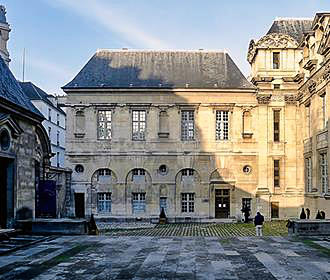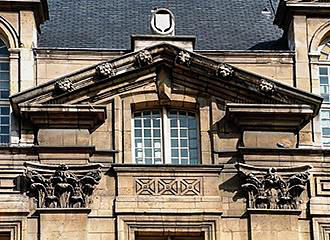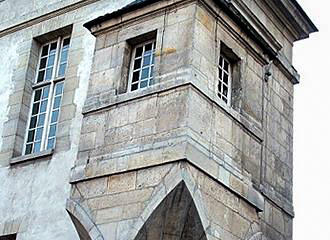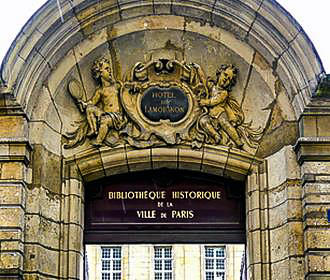The Hotel Lamoignon Mansion House in Paris
The Hotel Lamoignon, sometimes known as the Hotel d’Angouleme Lamoignon, is one of the oldest mansion houses in the Marais area of Paris and is now home to the Bibliotheque Historique de la Ville de Paris, which is the Historical Library of the City of Paris.
The Beginnings of the Mansion House
It all started when the legitimatised daughter of King Henri II, Diane de France, Duchess of Angouleme decided to purchase a plot of land at the St Catherine Monastery in the Marais area, which had been converted to vegetable growing land from wetlands, and then this became the preferred location for many aristocratic homes to be built during the 16th century.
Diane of France had this impressive mansion house constructed between the years 1585 and 1590, which was named the Hotel d’Angouleme. Designed around a courtyard and a garden area, there was a main building and two front buildings, and on these pediments you can discover symbols of Diana, the Goddess of hunting, portrayed with a dog, deer, the moon and trophies.
When Diane of France died, the Hotel d’Angouleme passed to her nephew, Charles de Valois, who was the illegitimate son of King Charles IX, however, he was a comrade in arms with Henri IV who granted him the rank of Marshal of France.
Charles de Valois, Duke of Angouleme decided to have the mansion house enlarged with a north wing, which was constructed in 1624, and a watchtower was also constructed, although it was more decorative than being defensive, yet is now one of very few remaining in Paris.
The Next Stages of the Mansion House
When Charles de Valois, the Duke of Angouleme died, the first President of the Parliament of France, Guillaume de Lamoignon then became the tenant of the mansion house.
He started to hold literary salons, or literary meetings at the mansion and by 1688 the Hotel d’Angouleme was purchased by the Lamoignon family who then changed the name of the mansion house from the Hotel d'Angouleme to the Hotel Lamoignon.
It was then that a portal was added to the building and two putti, which is basically a specific type of figure within a work of art, were added, and one was holding a mirror to depict truth, whereas the other is holding a snake that depicts prudence.
Other changes were also made to the Hotel Lamoignon including the balconies of the high windows that were decorated with ironworks in the King Louis XV style. The mansion remained in the family until Guillaume Lamoignon II had to leave when he was called up to the Chancellery of France in 1750, and from then it had tenants including Antoine Moriau.
Eventually, it was purchased by the architect Jean-Baptiste Le Boursier in 1774, and was then sold again in 1794 when it was divided up into 19th century homes, workshops and shops. In fact, Alphonse Daudet, who was a French novelist and father of writers Leon Daudet and Lucien Daudet, resided at the Hotel Lamoignon from 1867 through to 1876.
The Hotel Lamoignon Up Until Today
Unfortunately, much of the building had been altered and some of the Hotel Lamoignon gradually got into quite a state of disrepair, but by 1928 the City of Paris managed to acquire the building and start a major restoration project.
The City of Paris also constructed a modern wing upstairs from the courtyards and two levels were also dug out in the basement to house the Bibliotheque Historique de la Ville de Paris, which translates to the Historical Library of the History of Paris, that has become a significant landmark and tourist attraction in Paris.
Two effigies of the original owners dating back to the 17th century were also installed in the Hotel Lamoignon, which up until the French Revolution had been stored in a church by the Place des Vosges that has since been destroyed.
Yet this is one of the reasons why the mansion house is often known as the Hotel d’Angouleme Lamoignon, bar the fact that it had both names individually as you would have read earlier.
Eventually, after all the restoration work and the installation of the Bibliotheque Historique de la Ville de Paris, it opened to the public in 1969 and is still open to this day.



